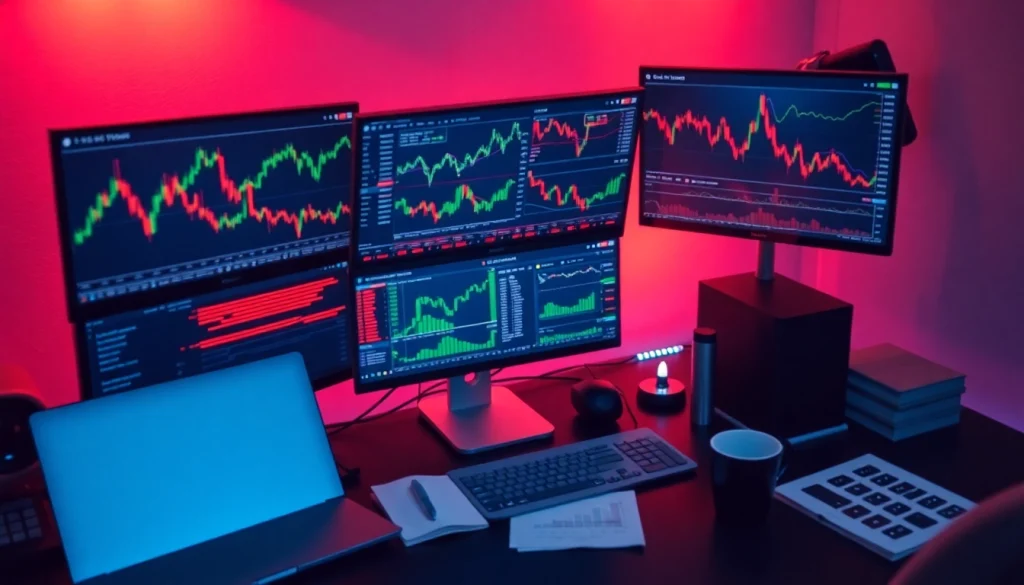
Understanding Tradings: The Basics
What is Trading?
Trading refers to the buying and selling of financial instruments, including stocks, commodities, currencies, and derivatives. In essence, trading is a way for investors to generate profits by speculating on the price movements of various assets. It can occur in various time frames, from milliseconds in high-frequency trading to several decades when holding assets for long-term growth. Trading can be done through various platforms, and the advent of technology has made this easier than ever, allowing people to engage in tradings from virtually anywhere in the world.
Types of Tradings Explained
There are several types of trading, each with its unique strategies and risk levels. Here are the primary categories:
- Day Trading: This involves buying and selling assets within the same trading day. Day traders capitalize on short-term market fluctuations and often execute multiple trades in a single day.
- Swing Trading: Swing traders hold positions for several days to capitalize on expected price moves. This strategy allows traders to benefit from market “swings” without needing minute-to-minute management.
- Scalping: Scalpers make numerous trades throughout the day, holding positions for only a few minutes or seconds. The goal is to achieve small, rapid profits by leveraging high trading volumes.
- Position Trading: This is a long-term strategy where traders maintain positions for weeks, months, or years, based on fundamental analysis and a strong market belief.
- Algorithmic Trading: This incorporates automated systems to execute trades based on predetermined criteria, which helps in optimizing trading efficiency and reducing human error.
Essential Terms Every Trader Should Know
Understanding the language of trading is crucial. Here are some essential trading terms:
- Market Order: An order to buy or sell a financial instrument immediately at the current market price.
- Limit Order: An order to buy or sell a financial instrument at a specific price or better.
- Spread: The difference between the bid price (what buyers pay) and the ask price (what sellers receive).
- Liquidity: A measure of how easily an asset can be bought or sold in the market without affecting its price.
- Volatility: A measure of how much the price of a financial instrument fluctuates over time, often used as a risk indicator.
Getting Started with Tradings
Choosing the Right Trading Platform
Choosing a trading platform is a critical step for both beginners and experienced traders alike. A good platform should be user-friendly and provide a reliable trading experience. Here are some factors to consider:
- Regulation: Ensure that the platform is regulated by a recognized authority to protect your investments.
- Fees: Look for platforms with transparent pricing policies to avoid hidden charges that can eat into your profits.
- Instruments Offered: Ensure that the platform offers a wide range of assets, enabling you to diversify your portfolio.
- Customer Support: Choose platforms that provide excellent customer service to assist you whenever necessary.
Setting Up Your Trading Account
Once you’ve chosen a trading platform, setting up your account is the next step. Here’s a simple guide:
- Registration: Fill out an online registration form with your personal and financial information.
- Verification: Provide identifying documents as required by the platform’s regulations to verify your identity.
- Deposit Funds: Deposit an initial amount into your trading account; this will vary depending on the platform’s minimum deposit requirements.
- Familiarize Yourself: Explore the platform and familiarize yourself with its tools and features before executing any trades.
Common Trading Mistakes to Avoid
Avoiding common pitfalls is critical for achieving success in an often volatile market. Here are a few mistakes new traders typically make:
- Lack of Research: Traders who do not conduct thorough research before trades often incur losses. Always analyze market conditions.
- Emotional Trading: Avoid letting emotions dictate your trading decisions. Stick to your strategy regardless of market fluctuations.
- Over-Leveraging: Using excessive leverage can magnify losses. It’s essential to balance potential returns with the risk involved.
- Ignoring Stop-loss Orders: Failing to place a stop-loss order can lead to significant losses in adverse market movements.
Effective Strategies for Successful Tradings
Technical Analysis vs. Fundamental Analysis
Understanding the two primary analytical approaches in trading can significantly enhance performance:
- Technical Analysis: This method focuses on historical price movement and trading volume. By using price charts and various technical indicators (like moving averages and RSI), traders aim to forecast future price movements.
- Fundamental Analysis: This approach looks at economic indicators, company performance metrics, and broader market trends to determine asset value. Traders use information such as earnings reports, GDP growth, and interest rates to gauge future movements.
Day Trading Strategies Explained
Day trading requires specific tactics due to the fast-paced nature of the market. Here are some effective strategies:
- Momentum Trading: This involves buying stocks that are moving significantly in one direction on high volume, aiming to capitalize on early momentum.
- Scalping: As mentioned earlier, this involves making multiple trades throughout the day to profit from small price gaps.
- Range Trading: Range traders focus on identifying consistent high and low levels in stock prices to capitalize on range-bound movements.
Long-term vs. Short-term Tradings
The distinction between long-term and short-term trading strategies is vital for aligning your trading style with your financial goals:
- Long-term Trading: This involves holding assets for an extended period, which can significantly reduce the emotional burden of market volatility and is typically beneficial for wealth accumulation.
- Short-term Trading: This style focuses on quick profits. While potentially yielding high rewards, it comes with increased stress and the need for thorough technical and market analysis.
Tools and Resources for Enhanced Trading Performance
Top Trading Software and Tools
Utilizing the right tools can enhance your trading effectiveness. Here are some essential software options:
- TradingView: A popular charting tool that offers advanced analysis, real-time data, and social networking for traders.
- MetaTrader 4/5: Widely used for forex and commodities trading, providing powerful analytics and automated trading options.
- ThinkorSwim: A robust platform for trading a wide range of securities, offering detailed market research and powerful trading tools.
Educational Resources for New Traders
Education is key to becoming a successful trader. Consider the following resources:
- Webinars and Online Courses: Look for reputable sources like Investopedia, Coursera, or other financial education platforms offering comprehensive trading courses.
- Books: Reading trading books can provide in-depth strategies and insights. Consider titles like “A Beginner’s Guide to Forex Trading” or “Market Wizards” for valuable perspectives.
- Community Forums: Join online trading communities where you can share experiences, ask questions, and learn from fellow traders.
Staying Updated with Market Trends
Staying informed is crucial in the fast-paced trading environment. Utilize these methods to keep up with market trends:
- Financial News Websites: Platforms like Bloomberg, CNBC, and Reuters offer up-to-date financial news and analysis.
- Economic Calendars: These provide information on upcoming economic events that may impact market conditions and trends.
- Social Media and News Aggregators: Follow financial experts and analysts on platforms like Twitter and use news aggregators to filter relevant information.
Evaluating Your Trading Performance
Key Metrics to Measure Success
It’s essential to evaluate your trading performance regularly. Here are critical metrics to consider:
- Win Rate: The percentage of trades that were profitable. A 50% win rate means half your trades are successful.
- Profit-Loss Ratio: This measures the average profit earned relative to losses incurred. A ratio above 1 means you’re making more on winning trades than losing on others.
- Average Trade Duration: Understanding how long you typically hold positions can help refine your strategy based on market conditions.
Adapting Your Strategy Based on Performance
It’s important to reassess your trading strategy in light of your performance metrics:
- Benchmark Against Historical Data: Compare your performance to historical results and industry standards to identify areas for improvement.
- Adjust Risk Management: If you’re exceeding risk tolerance levels, consider adjusting stop-loss settings or reducing position sizes.
- Learn from Losses: Analyze losing trades to understand what went wrong and refine your strategy to avoid repeating the same mistakes.
Building a Trading Journal
Creating a trading journal is one of the best practices for ongoing improvement. It should include the following:
- Trade Details: Date, asset traded, entry and exit points, and rationale for each trade.
- Outcomes: Record whether it was a win or loss and analyze the reasons behind the outcome.
- Emotional State: Log your emotions during the trading process to understand their impact on decision-making.



